Whip anatomy
Cracker/ Popper
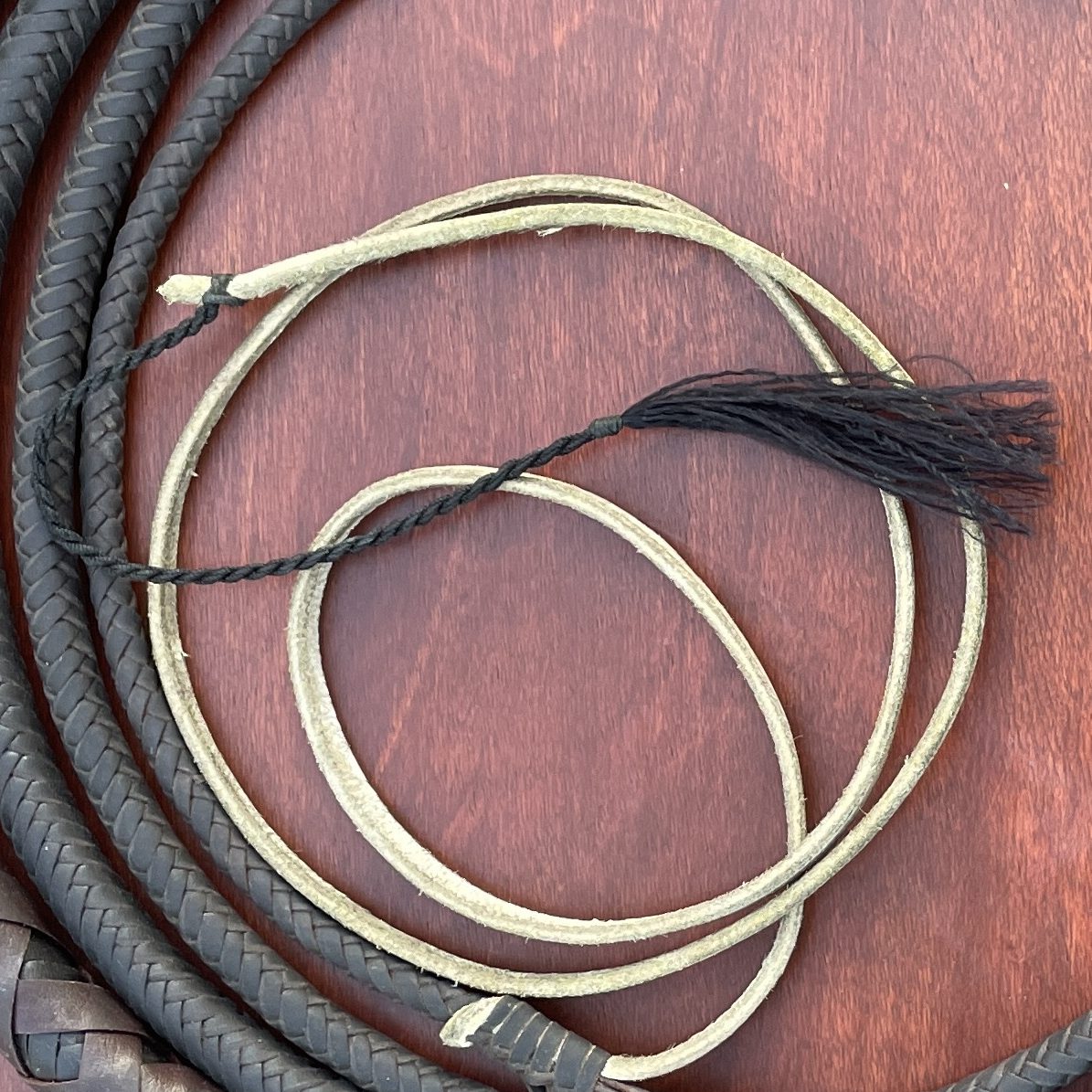
The popper is the very last attachment to the tail end of the whip, and may look like a thin twisted length with a short tassel. It serves the purpose of aligning the whip’s flight path, and is what generates the crack as the whip rolls out.
Fall

This is a replaceable length that continues the taper of the whip past the fall hitch at the end of the braiding. In kangaroo whips it’s most commonly latigo, white hide, or red hide, which are all tannages of cow leather. In nylon whips, the fall is usually a slightly different preparation of the same cord that was used to braid the thong. The fall is made as a secondary attachment because of the wear it will undergo, being at the end of the whip that makes the most contact with the environment. You can expect your fall to last a long time, but this time does vary, and when your fall is too worn out to be of use, you will need to replace it.
Fall Hitch
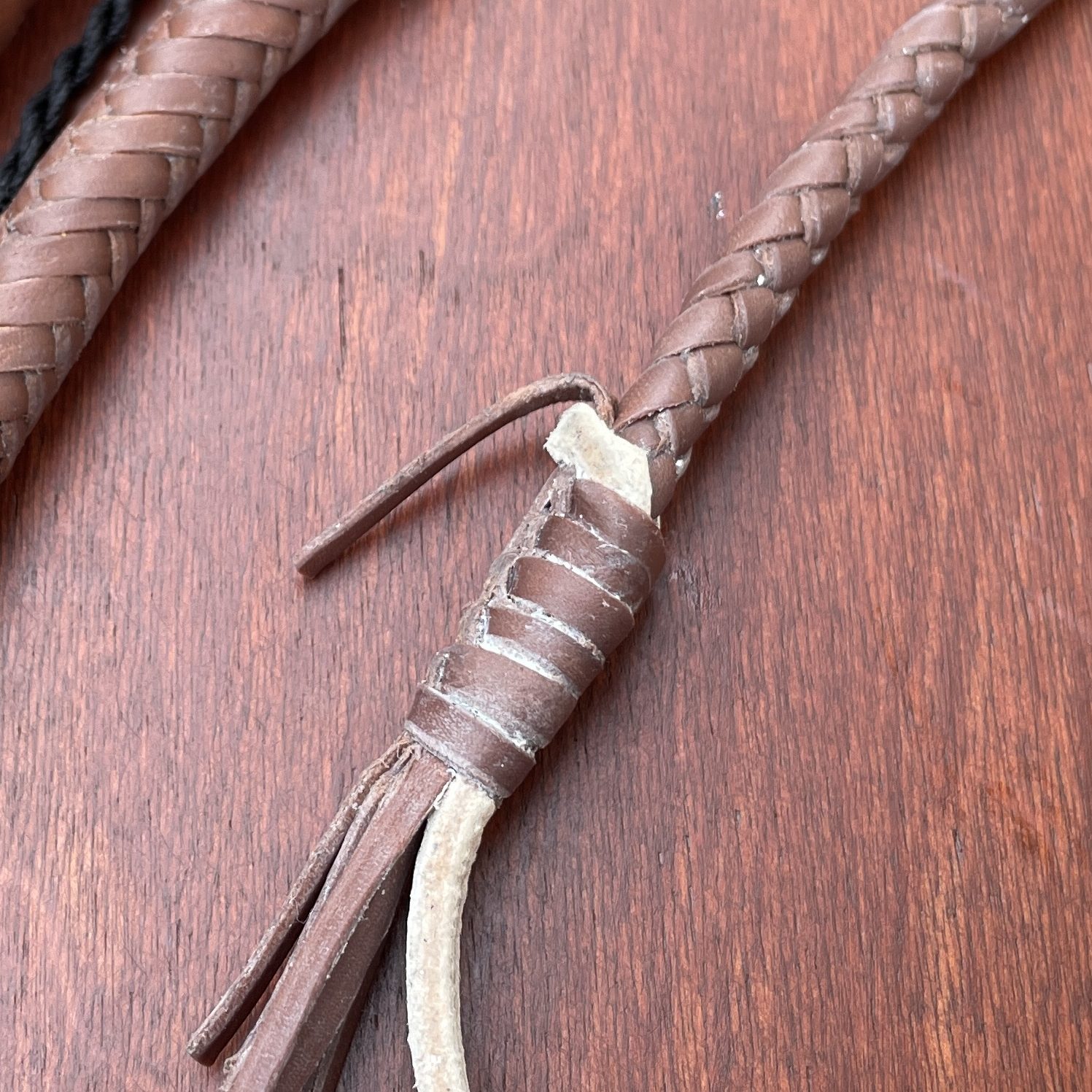
The fall hitch can be seen near the narrow end of the whip, where the braiding in the thong stops and the fall starts. It may look like a series of ridges with some tails coming out (like an Indiana Jones bull whip), or in the case of some nylon whips it may look like a small square knot, or lots of other ways. Good whip care practices include both preventative and restorative care for the fall hitch. Some whips do not have fall hitches.
Handle

The rigid portion of the whip, which serves as a lever unto the thong. For whips that are entirely thong with no rigidity, the word “handle” is still used to refer to the same area, adjacent to the heel.
Heel

The large knob at the thickest end of the whip, which serves to facilitate grip and control of the handle. Many whips (but not all) have a counterweight in the heel, usually lead, which alters the handling nuance of the whip.
Keeper
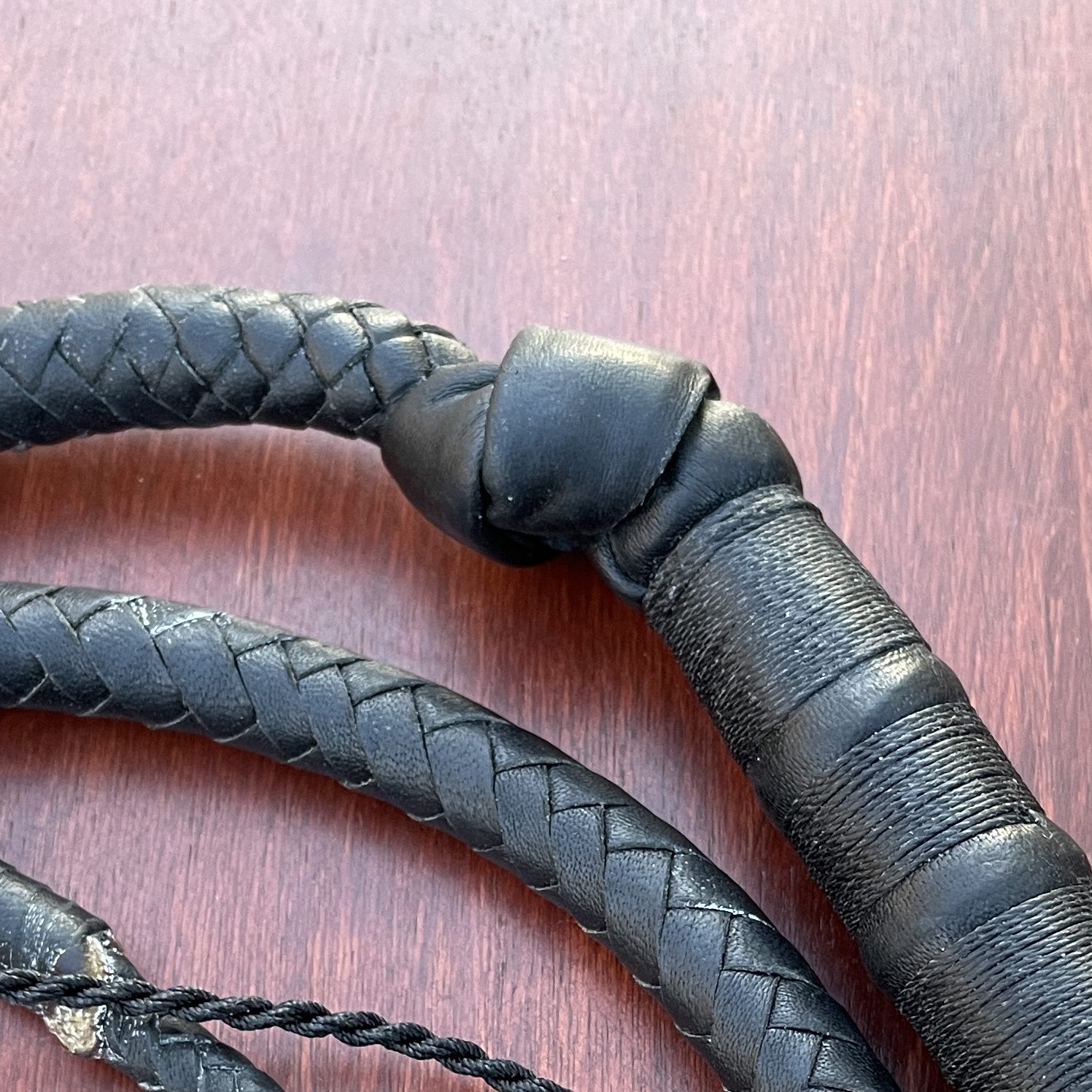
The keeper is unique to Australian stock whips, and is the knuckle that joins the handle and thong together. The loop at the narrow end of the handle and the loop at the thicker end of the thong are also individually referred to as keepers.
Thong
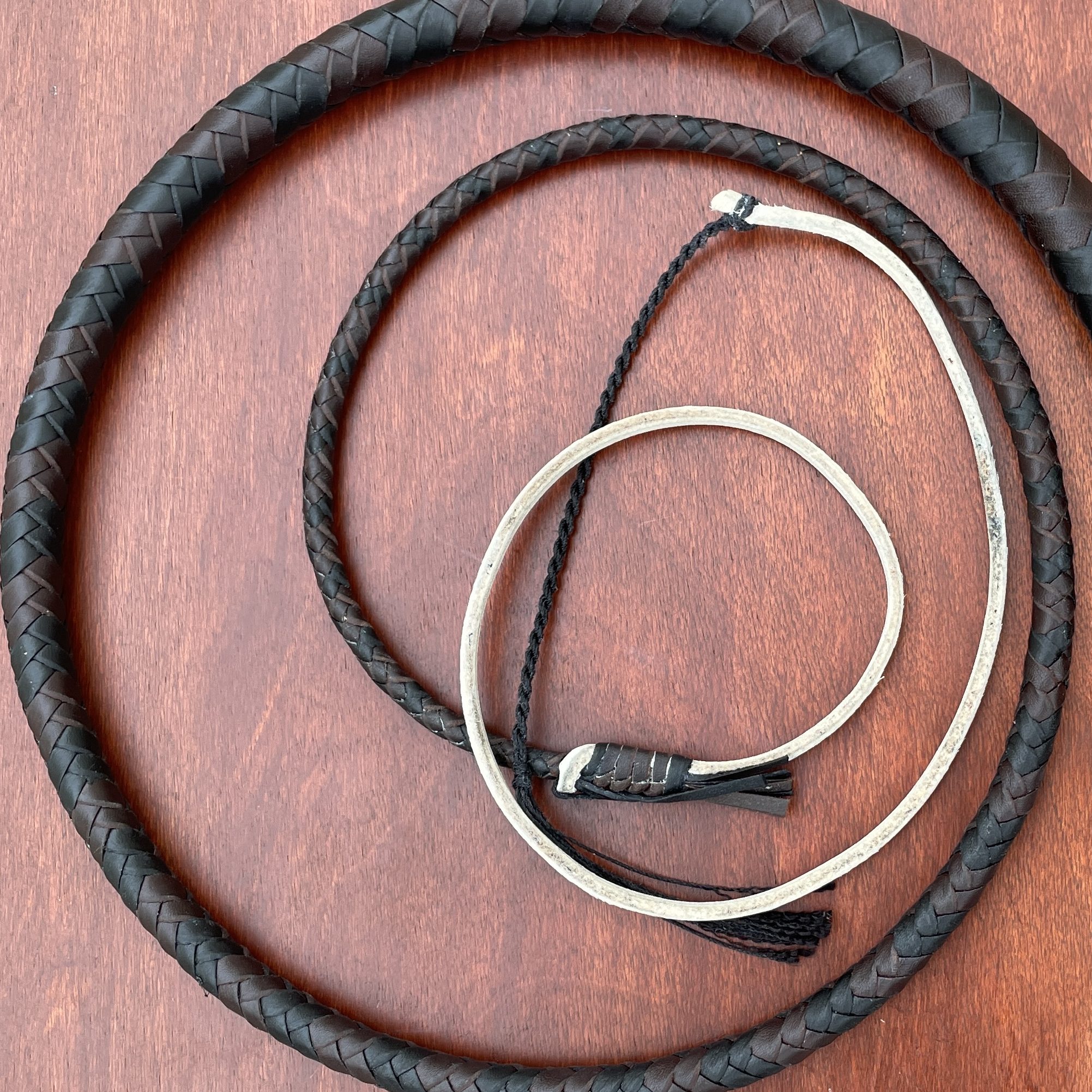
The thong of a whip is the flexible portion, as opposed to the rigid handle. In modern whip industry terms, the fall and popper are not considered part of the thong. Snake whips have no rigid handle and are thus entirely thong, with the aforementioned exceptions of the fall and popper.
Transition
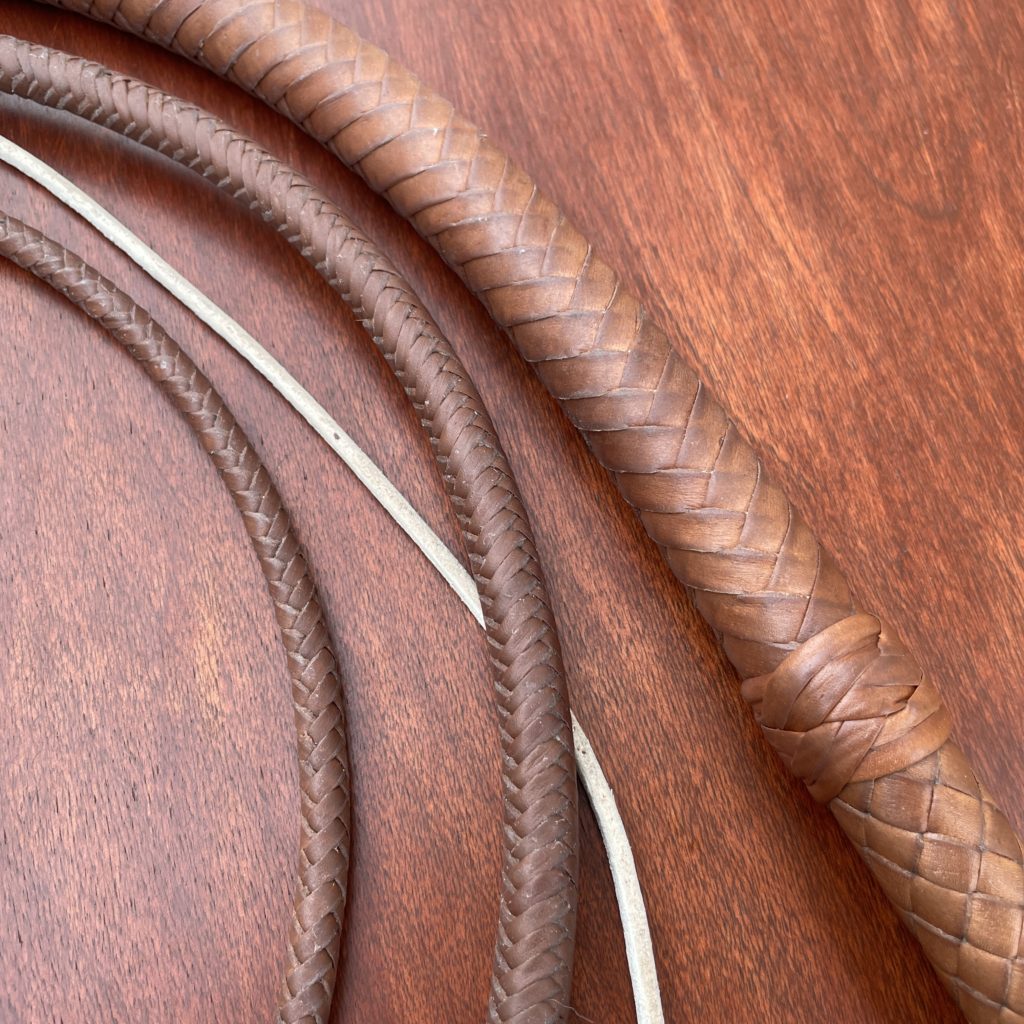
Put simply, this is the area of the thong that is closest to the handle. It is the transition from a section of high stiffness (generally, the handle) to a section of high flexibility (the thong of the whip). In bull whips, generally the transition is reinforced with tighter braiding or sometimes other means. It’s important for bull whips to have strong transitions, because the wear the handle core can exert from the inside of the whip over many years can sometimes be enough to damage it irreparably. Other whips like hybrids and stock whips don’t experience this same issue because of how they’re constructed, but of course they can still break down in other ways.
Transition Knot
Also called an accent knot or sometimes a ring knot, this is the small knob at the end of the handle opposite the heel. The accent knot is an artistic addition, most commonly used to cover the spot where the whip maker changed braiding patterns. A whip may have one accent knot, several, or none.
Wrist Loop
Commonly a flat braided strap affixed to the heel of a whip. The hand can be passed through the loop to help maintain purchase, but often a whip is also intended to hang by the loop for storage or display. Some whips almost always have wrist loops, like signal whips, and some whips never have them, like Australian stock whips.
Technical Terms
Plane
Hairpin
Follow Through
Flick
Figure 8
Whip making terms
It’s useful to know how to talk about the construction of a whip when you’re deciding whether you want to invest in a certain craftsperson and don’t know what to expect.
Balance
The balance of a whip can be considered to be the functional intersection of its physical attributes. There are many component factors that inform the balance of a whip, including weight distribution, density, taper, handle length, and any counterweighting. A well-balanced whip will (with good technique) produce a loud crack with minimal effort, move efficiently and gracefully between cracks, and cause no undue strain on the handler’s body. It’s important to note that the optimal balance of a whip depends on the type of whip, the techniques it’s being used for, and of course the handler’s preferences. If you commission a whip from a professional whip maker, you can make special requests for dimensions or weighting; otherwise the maker will probably just balance the whip to their own taste.
Belly
This refers both to a braided layer inside a whip, and to the entirety of the assembly prior to the application of the overlay. There is an implicit reference to the thong rather than the handle as well, in that you might call the handle foundation a core component, but generally not a belly component.
Bolster
A bolster is a filler layer usually placed between braided bellies, which adds mass, contributes to the overall taper, and provides a smooth surface for the next layer of braiding. Generally only leather whips have bolsters, and a bolster is most likely to be cow leather or kangaroo leather. You should always feel empowered to ask your craftsperson what they use for bolsters, but because of the purpose it serves, it usually doesn’t matter what leather the bolster is.
Core
The innermost component of a whip, which varies based on the maker, the type of whip, and many other factors. A nylon whip may have nylon at its core or it may have steel ball bearings. A leather whip may have cow or kangaroo leather at its core, or it may occasionally have a small shot bag or a steel cable. The rigid center of the handle is sometimes called the handle core as well.
Foundation
This word is most commonly used to refer to the mound or knob that is built up to support a knot. For example, the knot foundation or heel foundation of an Indiana Jones style bull whip is typically a strip of lead wrapped around the handle and covered with a few layers of leather. The wrist loop is applied on top of the foundation, and then the heel knot is tied on top of everything. Sometimes a whip maker may also put down a small scrap of leather or a few wraps of sinew to build up a foundation for their accent knot. This isn’t always necessary, but is largely a matter of taste. The rigid core of the handle is also sometimes called the handle foundation.
French Grapevine
This is an accent very commonly found on stock whips and hybrids, that presents as a spiral ridge crawling down a short section of the handle.
Herringbone
This is the single most common braiding pattern in the craft. In this pattern, four seams are formed down the length of the whip, defined by the aligned vertices of each pair of intersecting strands. This pattern is sometimes also referred to as “whip maker’s plait” or as a whip maker’s “Vs”. Herringbone is used so widely because it’s a stable way to structure the strands, and is VERY fast to execute by comparison to other patterns. To braid a herringbone pattern, the working strand is led under half of the strands running perpendicular to it, then over the other half.
Interweave
Knots are commonly tied in two steps; the first step is the base knot, which is essentially a lattice framework, and the second step is the interweave, which fills in the gaps and alters the texture and/or coloration of the knot. Some knots have multiple interweaves, making the texture more complex and allowing more colors to enter the pattern as well, if desired. Interweaves are also occasionally added to small sections of overlay braiding by particularly skilled craftspeople, which can be a fascinating visual element.
Knot
Knots are a common feature across almost all kinds of whips, and have infinitely variable size, texture, and complexity. You may recognize a knot as a small raised accent on the whip that is fairly obviously not part of the overlay braiding. They are typically the final addition to a whip, and can be used to create visual intrigue or cover up mistakes. The largest knot on a whip is the heel knot, which is gripped directly during use. A knot can exhibit all the same texture patterns as a braid can, but follows different rules for coloration.
Overlay
The overlay is the final, visible braided layer of the whip. This does not include the knots, wrist loop, fall, or popper. When we talk about the plait count of a whip (for example, 12 plait, 16 plait, etc), we are referring to the overlay. An overlay can be a single color, or several. It may have 4 strands, or it may have 64 or more strands. The overlay can be considered the craftsperson’s broadest canvas in terms of composing the visual intrigue of the whip. Generally speaking, a whip with more strands in the overlay can be expected to be more flexible than a whip with fewer strands.
Plait
The word “plait” is both a verb and a noun, used almost interchangeably with the word “braid”. There is some dispute over the nuance in meanings, but you’ll generally be understood no matter which one you use. The most common usage of “plait” is in overlays, for example, “a 24 plait whip” has 24 braided strands in the overlay. In the same way as “plait” is essentially synonymous with “braid” as a verb, “plait” is largely synonymous with “strand” as a noun; you may also say that a whip has a “24 strand overlay”, and it will be understood that it is a 24 plait whip. To plait is to braid, but “a plait” may also isolate a single specific section of a particular strand within a braid.
Short Herringbone
Short herringbone is, predictably, a variation of the herringbone pattern. Both patterns produce lengthwise seams in the braid, but short herringbone generates more seams depending on the number of strands used. In an 8 strand round braid, herringbone is indistinguishable from short herringbone; but for braids of 12 strands or more the two patterns are distinctly different. Instead of an under-half-over-half sequence, each strand is worked in an under2-over2 sequence through the strands running perpendicular.
Shot Bag
A shot bag is usually a tapered leather shell filled with lead shot. It serves as the core of the whip, and in the case of signal whips and small snake whips, may comprise the entire belly. If a whip is made with a shot bag, you may also say that the whip is shot loaded. There are a few different ways to shot load a whip, especially in nylon whip making, but in leather whip making it’s almost always done with a shot bag.
